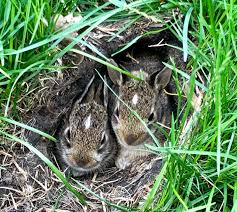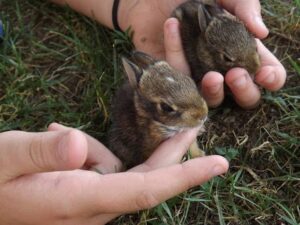Wild bunny rescue refers to the act of rescuing a wild rabbit, typically a young or injured one, and providing it with necessary care and support until it is able to return to the wild on its own.
This may involve providing the bunny with food, water, shelter, and protection from predators, as well as seeking veterinary care if necessary. Wild bunny rescue can be a challenging and delicate process, as rabbits are fragile animals and may not survive without proper care.
It is important to note that wild rabbits should generally not be taken from their natural habitat unless they are in immediate danger and require intervention. It is best to seek the advice of a wildlife rehabilitation professional before attempting to rescue a wild bunny.
If you find an injured or orphaned wild bunny, it is important to act quickly to ensure its safety and well-being. If you find an injured bunny, it is important to take it to a licensed wildlife rehabilitator as soon as possible. Do not attempt to care for it yourself, as wild bunnies have specific dietary and environmental needs that are difficult to replicate in a home setting.
Wildlife rehabilitators are trained to care for wild animals and can provide the bunny with the proper care it needs. If you find an orphaned bunny, try to determine if it truly has been abandoned by its mother. Mother rabbits often leave their young alone for extended periods of time, only returning to the nest at dawn and dusk to nurse.
If you suspect that the mother has abandoned the bunny, you can attempt to reunite them by placing the bunny back in its nest and monitoring it from a distance. If you are unable to reunite the bunny with its mother, contact a licensed wildlife rehabilitator for assistance.
It is very important to remember that wild bunnies are not suitable as pets and should be returned to their natural habitat as soon as they are able to survive on their own. Interacting with wild bunnies can also be dangerous, as they may carry diseases such as tularemia and can cause injury with their powerful hind legs.
History and Development of the Wild Bunny Rescue

Wild Bunny Rescue organizations can be traced back to the late 19th and early 20th centuries, when wildlife rehabilitation began to gain popularity in Europe and North America.
In the early days, rehabilitation efforts were often focused on larger mammals such as bears and deer, but as interest grew in the rehabilitation of smaller animals, organizations began to form to focus specifically on rabbits and other small wildlife.
One of the earliest and most influential organizations in the field of wild bunny rescue is the House Rabbit Society, which was founded in 1988 in Richmond, California.
The House Rabbit Society began as a small group of individuals who were concerned about the welfare of domestic rabbits, but soon expanded their focus to include the rescue and rehabilitation of wild rabbits as well. Over the years, the organization has grown significantly and now has chapters all over the world.
Another key organization in the field of wild bunny rescue is the International Wildlife Rehabilitation Council (IWRC), which was founded in 1972. The IWRC is a professional organization that provides training, education, and resources for wildlife rehabilitators, including those who work with wild rabbits.
Today, there are many different organizations and individuals involved in wild bunny rescue efforts around the world. These organizations and individuals work to rescue injured or orphaned wild rabbits, provide medical care and rehabilitation, and release them back into the wild when they are healthy and able to survive on their own.
Many wild bunny rescue organizations also work to educate the public about the importance of wildlife conservation and the need to protect and preserve natural habitats for wild rabbits and other wildlife species.
Read Also: Cercospora Leaf Spot – Symptoms and Damage Prevention
The Importance of Wild Bunny Rescue

Wild bunny rescue is important for several reasons, some of the reasons are:
To prevent suffering: Wild bunnies that are injured, sick, or orphaned can suffer greatly without proper care. Rescuing and providing care for them can help alleviate their suffering and increase their chances of survival.
To maintain ecological balance: Wild rabbits play an important role in many ecosystems, as they are preyed upon by many predators and help to keep plant growth in check. Rescuing and rehabilitating injured or orphaned rabbits can help to ensure that the population remains stable and healthy.
To promote conservation: Many species of wild rabbits are threatened or endangered due to habitat loss, hunting, and other factors. Rescuing and rehabilitating injured or orphaned rabbits can help to promote conservation efforts and raise awareness of the importance of protecting wild animals and their habitats.
To educate the public: Wild bunny rescue can be an opportunity to educate the public about wildlife and the importance of conservation efforts. It can also help to dispel myths and misunderstandings about wild animals and their behavior.
Additionally, wild bunny rescue is an important and worthwhile endeavor that can help to protect and preserve these adorable and valuable members of our ecosystems.
Read Also: Leafhopper or Jassid – Symptoms and Damage Prevention
Where to Find Wild Bunny Rescue near Me/You

If you come across a wild bunny that appears to be injured, sick, or orphaned and requires rescue, it is important to seek the advice and assistance of a wildlife rehabilitation professional.
These professionals have the training and experience necessary to care for wild animals and help them return to their natural habitats.
To find a wildlife rehabilitation center in your area, you can:
Check online: You can use search engines to look for wildlife rehabilitation centers in your area. Websites such as Animal Help Now and Wildlife Rehabilitation Directory provide databases of wildlife rehabilitators by state or region.
Contact local animal control agencies or wildlife organizations: Your local animal control agency or wildlife organization may be able to provide you with information on nearby wildlife rehabilitation centers.
Ask a veterinarian: Your veterinarian may also be able to refer you to a local wildlife rehabilitation center.
When contacting a wildlife rehabilitation center, be sure to provide as much information as possible about the wild bunny, including its location, condition, and any observed symptoms or injuries.
The staff at the rehabilitation center will provide guidance on how to safely capture and transport the bunny, and will advise on next steps for its care and recovery.
Read Also: Domestic Waste Complete Management Guide
